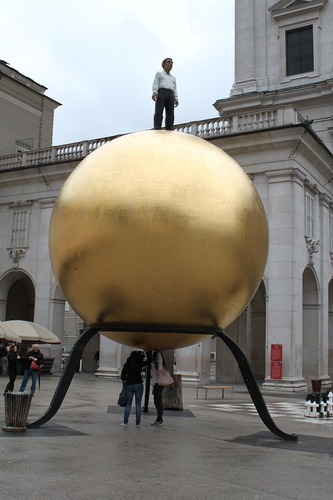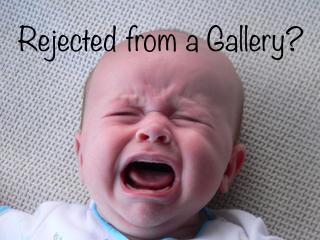7 Reasons why Art Galleries might reject your Artwork
You got rejected, does this mean your artwork sucks?
A lot of artists assume they get rejected from a gallery because their artwork isn't good enough, but it's not always the case.

Over the years I have worked in several galleries, and I have learned that sometimes it can just be as simple a matter of an artist being 'too difficult' to deal with.
Some of the best-selling artists have been dropped from shows because working with them is a nightmare from start to finish. Trying to get them to create work. Demands for the best wall space, or pestering for better treatment or more money than other artists. Some expect to jump the queue because they are ‘such and such' with overinflated egos.
I’m not just saying these artists are necessarily bad people. Sometimes they were actually very nice. They just didn't know how to operate professionally.
Reasons:
Presentation of your work, timeliness, and keeping your records organised are all factors. I came across artists who expected the gallery to be aware of where their work was at any time, including art that has not yet arrived. As a matter of fact, there have been instances where artists have sworn black and blue that a specific gallery has their artwork only to find that they had taken it elsewhere or it hadn't even left the studio! So make sure you keep good records, especially if you deal with multiple galleries.
In reality, having a gallery love your work is only one very small part of what goes into the decision to represent an artist.
Bringing on a new artist is a business gamble, much like buying a good house in a good neighbourhood, if you're into property investment, it has to be an investment that will deliver good returns since that's what they'll do, they'll invest in you. They need to be sure that your work is going to be popular with their buyers and bring in many sales so making a profit for them.
It’s Nothing Personal.
Liking an artist's work is certainly an important factor, but there are other reasons a gallery must take into account before committing to an artist. Having a clear understanding of those will allow you to successfully present your work to galleries and remove that inevitable feeling of failure that follows when a gallery rejects your work.

Although some of these reasons are generalisations, they are not always the case.
Galleries will love your work or despise it for very different reasons but fortunately those are rare.
There’s Lack of Experience
Often, artists approach galleries too early, before they've fully developed their work.
Galleries want to make sure that once they commit to you, your work will not make radical or unpredictable changes. Even if a gallery really likes your work, they may want to watch your development over a period of years to confirm their initial opinion.
You also need to have a body of work that shows your unique style and brand, and is sufficient to have an exhibition. It wasn’t unusual to see beginner artists come in with their first two paintings expecting to be able to sell their work and become a top selling artist. It's not like mowing the lawns once or twice and deciding to start up a lawn-care service. Experience and development is really key.
Or too Similar to Other Artist’s Work
if your artwork is too similar to other artists they already represent, you may be rejected for that. It’s a wise idea to approach galleries that have a ‘similar’ style of artwork to yours i.e. landscape and portrait work or abstract contemporary styles.
If you paint people with square heads and they already have an artist who paints people with square heads, it's highly unlikely they will want two of you. So try to find a unique style of your own for a point of difference.
Deemed to be too Different
galleries like to represent artists whose work is similar as described in reason two. It’s not sound business practice to have a huge range of styles and genres. Each gallery will have their own following and clientele who are looking for certain things.
It’s like an Optometrist stocking a range of slippers, you just wouldn’t! If your work is outside their usual genre then that is a valid reason, e.g. a gallery specialising in large minimalistic abstracts is not going to take on your delicate watercolour scenes of mountains and lakes or vice versa.
Sometimes it can be Overpriced $$$$$$$$$$$$$$
Some artists have a totally unrealistic sense of how to charge for their work.
Prices should be worked out on the law of supply and demand. If a gallery feels they cannot price your work fairly and still make their cut on commission, they won’t be likely to take a chance on you.
Galleries will take from 30 – 60% of the sale price, you need to take that into account when pricing your artwork. And it's usually the higher end of that. So if you want $5000 for your piece, its sales tag could be $8000
Maybe it's Under-priced or looks Cheap $$$
if your work isn't likely to make much money for the gallery, they won't be as interested in selling it. You tell the gallery to sell your painting for $200, but they will only make $80 from it.
Since they have limited wall space and overheads to cover, every inch of wall space needs to bring in the highest price possible. Keep in mind your cut probably won’t cover the cost of your canvas either, never mind the paints, other supplies and your time.
One artist I saw once, brought in artwork made from ice block sticks. One used cheap paper and recycled frames, which I'm not saying cannot be done, but it should be done well. These examples were not. So they were never likely to sell for much, as they weren’t finished to a high standard. Even though the actual work itself was good, the artists didn’t want to use quality materials and therefore did themselves out of representation with that gallery.
Take a look at this article on How to Price Your Artwork.
Is it too Difficult to Store?
most art galleries rarely have enough storage space. Work that is 3 dimensional, too fragile, too heavy, or too difficult to handle is also likely to be rejected.

Or are you Tricky to Deal With?
Dealing with galleries requires you to establish a relationship where you can discuss matters that can be difficult, such as describing artwork in detail and discussing money. Both the artist and the gallery need to have a level of trust and comfort that will guarantee honest communications. If a gallery sees you as being a difficult person to work with, they will most likely stay well clear of you.
The art world is small and people talk so your reputation will often precede you. Make sure it’s a positive impression!
End of the Day
It is possible that a gallery will not like your work. Rejection is more likely to happen than not, so try not to let it bother you. Having a thick skin is the most effective strategy to deal with it.
Keep in mind that there are hundreds of other artists out there, and few galleries, so it's challenging for every artist to get a lot of representation, if at all. I hear artists talk about being rejected by 9 out of 10 galleries. It's not uncommon even for well-known artists. Just keep persevering, and look for the one in ten that will say yes!
Posted: Wednesday 30 June 2010
